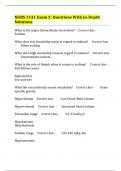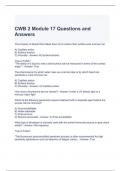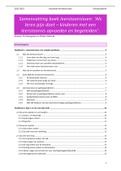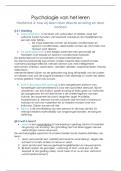Chapter 2 Amino acids and proteins
An amino acid had a central carbon to which a basic amino group (NH2), an acidic carboxyl group
(COOH), a hydrogen atom (H) and a distinctive side chain (R) are attached. Except for glycine, all
amino acids contain at least one asymmetric carbon atom, these isomers are chiral, which means
they are mirror images of each other. Amino acids with charged, polar or hydrophilic groups are at
the surface of a protein, nonpolar and hydrophobic residues are at the centre of a protein. There are
different types of amino acids:
Aliphatic – saturated hydrocarbons as side chain.
Aromatic – aromatic side chains.
Neutral polar – hydroxyl or amide side chains
Acidic – carboxylic acids as side chains, negatively charged.
Basic – protonated side chains, positively charged.
Sulfur-containing – low polarity (hydrophilicity of an amino acid)
The overall charge on a protein depends on the contribution from basic and acidic amino acids, but it
varies with the pH of the solution. Henderson-Hasselbach equation > formuleblad. Buffers are
solutions that minimize a change in pH on addition of acid or base.
The primary structure of the protein is the linear sequence of amino acids. The secondary structure is
determined by hydrogen bonding interactions of carbonyl and amide residues in the peptide
backbone. The secondary structure can be an α-helix or a β-pleated sheet. The tertiary structure is
the overall shape of the molecule, which results from folding of the peptide chain, this structure is
stabilized by covalent disulphide bonds, hydrogen bonds, salt bridges and hydrophobic interactions.
The quaternary structure is the complex of two or more separate peptide chains, held together by
(non)covalent interactions.
Protein purification procedures work on separations based on charge, size, binding properties and
solubility. There are the following purification methods:
Salting out: ammonium sulphate is added and some proteins will precipitate.
Dialysis and ultrafiltration: adding protein-salt solution to a semipermeable membrane tube,
add dilute buffer and the small molecules will pass through. Ultrafiltration uses pressure to
force a solution trough a membrane.
Gel filtration: differential migration of dissolved solutes through gels that have pores of
defined sizes.
Ion exchange chromatography: proteins are separated on basis of charge, proteins are
gradually eluted from the column and resolved based on their pI.
Affinity chromatography: a ligand binds to a specific protein, the other proteins wash
through the porous column.
SDS-PAGE: proteins move at different rates in the electrical field, depending on their charge
to mass ratio. SDS separates and resolves protein subunits according to molecular weight.
Isoelectric focusing (IEF): separation of proteins on their pI by conducting electrophoresis in a
micro channel or gel containing a pH gradient.
Proteins are analysed after the separation, hydrolysis starts and is followed by amino acid separation.
The primary structure of proteins can be determined by mass spectrometry. The 3D-structure of
proteins can be determined by x-ray crystallography and NMR spectroscopy.
Creutzfeld-Jakob is a human prion disease, where an abnormal isoform of a host-encoded protein
accumulates in affected brains.






